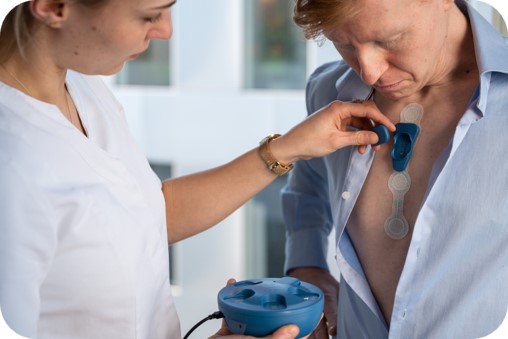Contact the following healthcare facilities directly:
MS Center Melsbroek
AZ Turnhout
Sint-Trudo Sint-Truiden
AZ Glorieux Ronse
AZ Jan Portaels Vilvoorde
Rehabilitation Hospital Inkendaal
door nexuzhealth op 7.3.2024

"If we can detect side effects faster and provide better follow-up using telemonitoring, then we can improve not only the quality of life but also the life expectancy of some cancer patients," explains Dr. Delforge, professor and oncologist at UZ Leuven. With telemonitoring, patient data is collected remotely and then monitored using digital technology so that the patient's health is continually being evaluated, within his or her home environment. Due to technological advances, the quest for greater efficiency, and the use of less invasive techniques, there has been an increase in the number of patients recovering at home. What’s more, the government increased the number of procedures which no longer require hospitalisation from 246 to 551 last year. In other words, patient follow-up is increasingly taking place outside the hospital itself and is therefore being performed by a wide variety of healthcare providers.
Telemonitoring plays a significant role in facilitating this shift towards more comprehensive transmural care. Not only by providing the doctor or another healthcare provider with important health data remotely, but also by promoting collaboration and coordination amongst healthcare providers. The significant challenge here is to exchange the collected data with the healthcare providers and patients in a secure and structured way. And to do that throughout the entire care pathway – from hospital discharge through the follow-up during their continued recovery at home. Proper integration with the EHR is essential in this regard.
With this in mind, nexuzhealth and Byteflies decided to join forces. Bob Neven, Director of Product Management at nexuzhealth: "Byteflies is an expert in optimising transmural care pathways with telemetry. As a way to relieve pressure on hospitals during the COVID-19 pandemic, the company developed an easy-to-use solution to monitor covid patients at home. After the pandemic, the company approached us, suggesting a collaborative effort to explore a more organised approach to telemonitoring. After all, in addition to capturing vital parameters in the home environment, the data-flow towards healthcare providers is also incredibly important. This is possible thanks to the integration with the EHR.
By making data available in one place, healthcare providers not only gain a broader view of the patient's health status, but they will all be looking at the same data. And that benefits communication as well as decision making." This formed the foundation for the OncoCare@home pilot project in 2022. UZ Leuven, Wit-Gele-Kruis East Flanders and the Leuven Kankerinstituut also joined the consortium. The goal of this project is to reduce the number of hospitalisation days by 10% and to significantly increase the life expectancy and quality of life of the cancer patients involved, for example, by more quickly detecting and following up on the side effects of their treatments.
Hans De Clerq, co-CEO of Byteflies: "Currently we are focusing on several specific care pathways. One of these concerns lung and esophageal cancer patients who, today, can be discharged earlier thanks to less invasive surgical techniques. But in these cases, side effects, which were previously detected relatively quickly in hospital, remain under the radar for longer. Some of these patients experience cardiac arrhythmias, such as atrial fibrillation, postoperatively. You can monitor these side effects perfectly using telemetry. Since the start of the project, more than 10% of the 28 patients have been diagnosed with atrial fibrillation."
For the exchange of medical information, nexuzhealth uses the HL7 FHIR standard (The Fast Healthcare Interoperability Resources standard is a set of rules and specifications for exchanging electronic healthcare data.). This standard is then combined with a PDF report that provides additional context for the measured parameters. Bob Neven: "It is important that the data is integrated in the EHR in a structured way. When combined with the data already available in the patient health record, it provides valuable insights. In addition, we endeavour, as an open platform, to maximise interoperability. This implies that there's no need to develop a new integration for each device supplier: If you capture the temperature of device A, the temperature of device B can flow in in the same way. And, therefore, other telemonitoring device manufacturers can also connect to the platform."
This is why both partners collaborated to achieve a telemonitoring prescription, which provides a standardised integration between telemonitoring providers, EHRs, and other stakeholders in the healthcare industry. By exchanging as much information as possible according to industry standards, healthcare providers will be able to obtain a much better view of the health data. And that can only benefit the follow-up and treatment of patients.
Meanwhile, the partners are also exploring other care pathways, particularly within cardiology and neurology, among other areas, to broaden their collaboration further.
Curious about the possibilities of telemonitoring and the EHR? Please contact info@nexuzhealth.com.
MS Center Melsbroek
AZ Turnhout
Sint-Trudo Sint-Truiden
AZ Glorieux Ronse
AZ Jan Portaels Vilvoorde
Rehabilitation Hospital Inkendaal